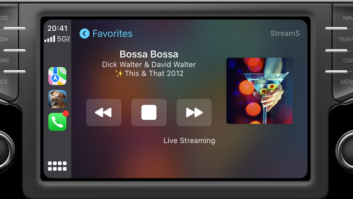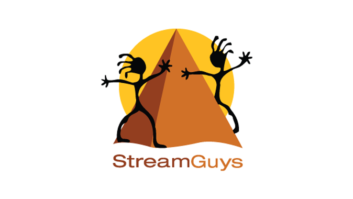Streaming Audio Ad Insertion
Sep 1, 2010 12:00 AM, By Doug Irwin, CPBE AMD
Add revenue to the online stream
If you look at the future of broadcasting as a contest between us (broadcasters) and them (streaming-media-only providers) then it would seem the game is ours to lose. After all, we have a built-in audience; a familiar way to promote the additional service to our established audience; and of course we already have the technical infrastructure in place to generate the program source for the stream.
If you already work with streaming media you know the online audience, while not as large as the over-the-air audience, is growing rapidly. Unlike our over-the-air audience (which costs the same to service whether one person listens or 1 million people listen) the online audience costs more and more as its size grows. (It may cost less on a per-stream basis, but it does cost more, nonetheless.) Naturally, then, we need to seek a means by which we can not only cover the extra costs associated with streaming, but perhaps (in time) even make a profit.
At least one way to do that is to use the familiar model we’ve been using: Sell spots on the stream that are different than what goes over the air. There are several different ways to accomplish this. First, I’ll detail how we do it here at Clear Channel NYC where everything is done in-house. Then I’ll discuss a hybrid approach — selling the ads in-house but using Ando Media software to integrate the ad-blocks smoothly. Finally, I’ll look at how Liquid Compass and Ando Media work in conjunction to provide streaming audio ad insertion.
Doing it all yourself
One way of handling ad insertion over streaming media is to do it all yourself — and this is the way it is done inside the Clear Channel system.

Figure 1. Handle all streaming ad insertion using a sound card such as the Orban Optimod-PC 1100 (or 1101). (Click image to enlarge.)
We have five FM stations here in New York, and each has about a half-dozen streams associated with it. Some of those streams are for desktop users and some are for mobile platforms (see “Streaming to Mobile Devices” in the April 2010 edition of Radio magazine). One computer is used for multiple purposes; it runs a log (using Nexgen from RCS) made solely of spot blocks to play over the streams. That same computer also houses an important sound card — the Orban Optimod-PC 1100 (or PC1101). This sound card is really the heart of the system, because it allows for the playback of the streaming-media spot blocks, and it processes the audio as well (ahead of all the various encoders). Figure 1 shows how this is done.
The streaming server CPU (that houses the Orban sound card) operates as a slave to the Nexgen server used for playback over the associated radio station. When a spot block starts, that slave machine is signaled (via our LAN) to play the spot block sent as streaming media, as opposed to over-the-air. A small routine called SB_Play is used on the slave machine to tell the Orban card to switch its direct mixer output from the source coming in on digital input 1 (which comes from our router, and is basically a copy of the on-air program) to the WAV out input, which is the actual source of the spot audio for stream use only.
The output of the direct mixer is then routed (internally on the Orban card) to the digital out, and thereafter an AES version of the direct mixer is available for use. From there, the signal is routed to a PPM encoder, and then back to digital input 2 of the Orban card. The digital 2 input goes through the process mixer and then to the audio processing section of the Orban card. The output of the processing section is routed back to the WAV in input, and back to the PCI bus where it becomes available for use on all the streaming encoders operating in that same machine. All the various streaming encoders make use of the same program feed.
— continued on page 2
Online Audience Measurement
Ando Media plays a huge role in online audience measurement. Doug Irwin talks to Robert Favre, senior vice president of technology for Ando Media….
Streaming Audio Ad Insertion
Sep 1, 2010 12:00 AM, By Doug Irwin, CPBE AMD
Add revenue to the online stream
When the spot block ends, the Orban card is signaled to resume using the program source coming from digital input 1 and thereafter it feeds the common program (heard by over-the-air users as well as stream-only users) to the inputs of all the encoders.
Our traffic department schedules the spot blocks for streaming media, just as it does for the spot blocks that run over the air on the associated radio station.
Some of the over-the-stream spots have visual elements associated with them. Metadata from the stream-only spots is forwarded (via our WAN) to our corporate streaming headquarters in Cincinnati, signaling servers there to add the visual elements by way of the Flash player used by the desktop-only streaming clients. Mass redistribution of the streams is handled by Akamai’s CDN.
A hybrid approach

Figure 2. Sell and traffic stream-only ads using Ando Media”s ad insertion software in conjunction with the system (in this case, Enco). (Click image to enlarge.)
I spoke with my friend Bryan Hubert, the chief engineer of Crista Ministry’s radio stations in Washington state about its hybrid approach to streaming audio ad-insertion.
Crista wanted to sell and traffic all the stream-only ads itself, and it recognized the capabilities of Ando Media’s ad-insertion software, so the group decided to use Ando in conjunction with its Enco system.
The system consists of two logs running in Enco, each with an associated audio output. A Broadcast Tools audio switcher is used to switch between sources, and that output is routed to the CPU where the Ando software resides (see Figure 2). This same CPU has an output that gets routed to a PPM encoder and then back. A streaming encoder then takes that PPM encoded source and sends it off to the Streamguys CDN for distribution to the end users.
— continued on page 3
Streaming Audio Ad Insertion
Sep 1, 2010 12:00 AM, By Doug Irwin, CPBE AMD
Add revenue to the online stream
When the log playing the common program gets to a spot block, several things happen:
- The Ando software is signaled by Enco 1 that a stopset has begun on the over-the-air station
- The log associated with the streaming audio ad-insertion (Enco 2) begins playing
- The audio router switches from Enco out 1 (common program) to Enco out 2 so that Enco 2 becomes the source of audio for the stream. Enco 1 is still playing audio for the over-the-air station’s program.
The buffering feature of the Ando software makes this process sound very smooth for the end-users of stream audio.Hubert told me that one important consideration in this process is that the spot block playing on the stream must be shorter than that playing over-the-air. For example, a spot block over-the-air is 4 minutes and 10 seconds in length, and the spot block for the stream is just 4 minutes. As the ad-insert audio is playing through the CPU that generates the stream, the Ando software (running on the same CPU) is waiting to receive a logic signal from Enco 1 (in this example) telling it that the over-the-air spot block is over. Because the spot block for the stream is, of necessity, shorter than that for the over-the-air signal, the Ando software does the following: - Fill material (stored on the CPU running the Ando software) will start to play at the end of the spot block for the stream.
- While the fill is playing, Ando is waiting to be signaled from Enco 1 that the over-the-air spotblock is over.
- Once that signal is received, Ando starts recording or buffering the output of the audio switch (which is now feeding the output of Enco 1)
- Once the fill material is played, Ando immediately switches over to its buffer, and so the normal common program is once again heard by end users of the stream.
So in this example, the over-the-air spot block was 4 minutes and 10 seconds. The stream-only spot block was 4 minutes. If Ando started a 30-second fill piece at the end of the stream-only spot block, then when all is said and done for this block, the stream audio is 20 seconds behind the over-the-air audio (ignoring any other types of delays used for the over-the-air signal). So if you were to listen to the stream source in one speaker and the over-the-air source in another speaker (again neglecting additional delays used for the over-the-air signal) you would note that the stream source is always behind that of the over-the-air source. The amount of time depends on the net difference in length of the spot blocks.The end-users hear a smooth transition when the stream source returns to the common program feed.— continued on page 4
Streaming Audio Ad Insertion
Sep 1, 2010 12:00 AM, By Doug Irwin, CPBE AMD
Add revenue to the online stream

Figure 3. Streaming ad insertion can also be accomplished using Liquid Compass Radius Live with Ando Media, as seen here. (Click image to enlarge.)
Yet another way to accomplish streaming ad insertion is to use Liquid Compass Radius Live in conjunction with Ando Media. See Figure 3.
The actual configuration is very much like the first system. Although two audio cards are shown, it can be done with a single card, again the Orban PC1101. In this case, the station sells spots for the stream ad insertion, but uploads them via the Internet to Ando, which in turn does all the trafficking, and then turns around and pushes the spots back out (again via the Internet) to the CPU that runs the software and physically resides at your radio station. The command to switch between the common program and the stream-only spot block can be delivered via your LAN or a serial connection.
As you might imagine, when you rely on outside services (such as Ando) there are network connectivity and security issues that need to be addressed. In the example I just gave, both Ando and Liquid Compass need remote access to each CPU running the software. It would be prudent to establish a separate Internet connection that would host the server(s), along with a hardware-based firewall that provides the appropriate security. Certain ports need to be open for each IP address on the secure side of the firewall. Remember that this same Internet connection will be used to get the stream out to the ISP or CDN that will in turn service each end-user, so it has to have enough bandwidth to handle all the connections at the same time, plus a safe amount of overhead. That is just one more expense involved in servicing the listeners of your audio stream.
If you are part of a large organization with its own WAN, then a VPN that allows companies like Liquid Compass access to the WAN might be a viable solution as opposed to an additional Internet connection per station location.
Some radio groups are large enough they can maintain staff that focuses on the streaming audio aspects of the operation; obviously some others are not. If your group is smaller, likely it makes financial sense to farm the entire process to companies providing hardware, software and CDN services to many of the smaller groups already.
There are three different ways to accomplish the same end. While selling Internet-only spots may have its own challenge for the sales team, I can tell you that, from the technical standpoint, all the trails are already blazed and there are vendors out there hoping to hear from you. Setting up streaming ad insertion isn’t difficult, and hopefully you can make it a viable part of your business.
Irwin is transmission systems supervisor for Clear Channel NYC and chief engineer of WKTU, New York. Contact him at [email protected]. Thanks to Barry Thomas for his help in writing this article.
–continued on page 5
Online Audience Measurement
Ando Media plays a huge role in online audience measurement. Doug Irwin talks to Robert Favre, senior vice president of technology for Ando Media….
Streaming Audio Ad Insertion
Sep 1, 2010 12:00 AM, By Doug Irwin, CPBE AMD
Add revenue to the online stream
Resource Guide
Providers of streaming ad-insertion technology
Abacast
866-872-0781
www.abacast.com
Akamai Technologies
877-325-2624
www.akamai.com
Audio Compass
888-62-AUDIO
www.audiocompass.com
Backbone Networks
508-753-5665
www.backbone.com
Barnabas Road Media
317-965-8505
www.barnabasroad.com
Jetcast
917-338-3289
www.jetcast.com
Liquid Compass
303-839-9400
www.liquidcompass.net
Live365.com
323-230-6000
www.live365.com
NewTek
800-847-6111
www.newtek.com
Orban
480-403-8300
www.orban.com
Real Networks
206-674-2700
www.realnetworks.com
Stream Audio
253-238-2187
www.streamaudio.com
Stream Guys
707-667-9479
www.streamguys.com
Stream On
951-801-2309
www.streamon.fm
Stream the World
866-448-4037
www.streamtheworld.com
SurferNetwork.com
973-691-7420
www.surfernetwork.com
Viewcast.com
800-540-4119
www.viewcast.com
Warp Radio
303-799-9118
www.warpradio.com











